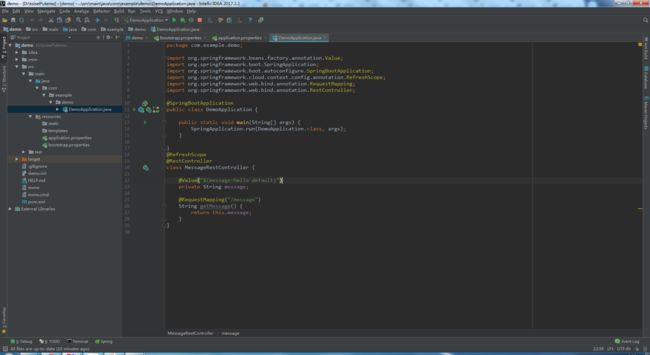出识springcloud我们这里需要建立两个项目 来感受下微服务
一、配置服务
1. Spring Initializr. 用idea自带的 Spring Initializr. 建立第一个项目
2.加入依赖
xml version="1.0" encoding="UTF-8"?>
<project xmlns="http://maven.apache.org/POM/4.0.0" xmlns:xsi="http://www.w3.org/2001/XMLSchema-instance"
xsi:schemaLocation="http://maven.apache.org/POM/4.0.0 https://maven.apache.org/xsd/maven-4.0.0.xsd">
<modelVersion>4.0.0modelVersion>
<parent>
<groupId>org.springframework.bootgroupId>
<artifactId>spring-boot-starter-parentartifactId>
<version>2.3.1.RELEASEversion>
<relativePath/>
parent>
<groupId>com.examplegroupId>
<artifactId>demoartifactId>
<version>0.0.1-SNAPSHOTversion>
<name>demoname>
<description>Demo project for Spring Bootdescription>
<properties>
<java.version>1.8java.version>
<spring-cloud.version>Hoxton.SR5spring-cloud.version>
properties>
<dependencies>
<dependency>
<groupId>org.springframework.cloudgroupId>
<artifactId>spring-cloud-config-serverartifactId>
dependency>
<dependency>
<groupId>org.springframework.bootgroupId>
<artifactId>spring-boot-starter-testartifactId>
<scope>testscope>
<exclusions>
<exclusion>
<groupId>org.junit.vintagegroupId>
<artifactId>junit-vintage-engineartifactId>
exclusion>
exclusions>
dependency>
dependencies>
<dependencyManagement>
<dependencies>
<dependency>
<groupId>org.springframework.cloudgroupId>
<artifactId>spring-cloud-dependenciesartifactId>
<version>${spring-cloud.version}version>
<type>pomtype>
<scope>importscope>
dependency>
dependencies>
dependencyManagement>
<build>
<plugins>
<plugin>
<groupId>org.springframework.bootgroupId>
<artifactId>spring-boot-maven-pluginartifactId>
plugin>
plugins>
build>
project>
3.修改application.properties文件 改个端口 不然后面启动两个项目端口冲突
server.port=8888
4.在你的git仓库中提交一个文件a-bootiful-client.properties 用以感受我们的springcloud项目与Git的结合使用
message = Hello world
文件中写上这个就行 便于等下测试
5。再次修改application.properties
spring.cloud.config.server.git.uri=https://gitee.com/你的仓库地址.git #spring.cloud.config.server.git.searchPaths=config # spring.cloud.config.server.git.username=你的用户名 spring.cloud.config.server.git.password=你的密码 spring.application.name=a-bootiful-client#刚才上传的文件名
6.修改DemoApplication 加上@EnableConfigServer注解
package com.example.demo; import org.springframework.boot.SpringApplication; import org.springframework.boot.autoconfigure.SpringBootApplication; import org.springframework.cloud.config.server.EnableConfigServer; @EnableConfigServer @SpringBootApplication public class DemoApplication { public static void main(String[] args) { SpringApplication.run(DemoApplication.class, args); } }
7.这个时候我们可以来建立第二项目啦
8.pom.xml
xml version="1.0" encoding="UTF-8"?>
<project xmlns="http://maven.apache.org/POM/4.0.0" xmlns:xsi="http://www.w3.org/2001/XMLSchema-instance"
xsi:schemaLocation="http://maven.apache.org/POM/4.0.0 https://maven.apache.org/xsd/maven-4.0.0.xsd">
<modelVersion>4.0.0modelVersion>
<parent>
<groupId>org.springframework.bootgroupId>
<artifactId>spring-boot-starter-parentartifactId>
<version>2.3.1.RELEASEversion>
<relativePath/>
parent>
<groupId>com.examplegroupId>
<artifactId>demoartifactId>
<version>0.0.1-SNAPSHOTversion>
<name>demoname>
<description>Demo project for Spring Bootdescription>
<properties>
<java.version>1.8java.version>
<spring-cloud.version>Hoxton.SR5spring-cloud.version>
properties>
<dependencies>
<dependency>
<groupId>org.springframework.bootgroupId>
<artifactId>spring-boot-starter-actuatorartifactId>
dependency>
<dependency>
<groupId>org.springframework.bootgroupId>
<artifactId>spring-boot-starter-webartifactId>
dependency>
<dependency>
<groupId>org.springframework.cloudgroupId>
<artifactId>spring-cloud-starter-configartifactId>
dependency>
<dependency>
<groupId>org.springframework.bootgroupId>
<artifactId>spring-boot-starter-testartifactId>
<scope>testscope>
<exclusions>
<exclusion>
<groupId>org.junit.vintagegroupId>
<artifactId>junit-vintage-engineartifactId>
exclusion>
exclusions>
dependency>
dependencies>
<dependencyManagement>
<dependencies>
<dependency>
<groupId>org.springframework.cloudgroupId>
<artifactId>spring-cloud-dependenciesartifactId>
<version>${spring-cloud.version}version>
<type>pomtype>
<scope>importscope>
dependency>
dependencies>
dependencyManagement>
<build>
<plugins>
<plugin>
<groupId>org.springframework.bootgroupId>
<artifactId>spring-boot-maven-pluginartifactId>
plugin>
plugins>
build>
project>
9.org.springframework.cloud:spring-cloud-starter-config依赖 然后在properties里配置 就能保证 在不需要重启jvm的情况下 (当然还需要别的依赖和操作请看到最后)刷新配置
这里 我写在了bootstrap.properties文件里 你也可以写在application.properties或者application.yml里
spring.application.name=a-bootiful-client
# N.B. this is the default:
spring.cloud.config.uri=http://localhost:8888
启用/refresh 修改application.properties
management.endpoints.web.exposure.include=*
10.客户端可以通过使用传统的机制(如访问所述配置服务器的任何值@ConfigurationProperties或@Value("${…}")或通过Environment)
package com.example.demo; import org.springframework.beans.factory.annotation.Value; import org.springframework.boot.SpringApplication; import org.springframework.boot.autoconfigure.SpringBootApplication; import org.springframework.cloud.context.config.annotation.RefreshScope; import org.springframework.web.bind.annotation.RequestMapping; import org.springframework.web.bind.annotation.RestController; @SpringBootApplication public class DemoApplication { public static void main(String[] args) { SpringApplication.run(DemoApplication.class, args); } } @RefreshScope @RestController class MessageRestController { @Value("${message:Hello default}") private String message; @RequestMapping("/message") String getMessage() { return this.message; } }
11.千辛万苦终于来到测试了
① http://localhost:8080/message 你会看见Hello world
②修改a-bootiful-client.properties(记得commit)的message 改为Hello spring 访问http://localhost:8888/a-bootiful-client/default你可以查看是否已经更改
③再点击http://localhost:8080/message这个你会发现依然是Hello world 字样what????不是说是无刷新获取的么????? 这个时候不要苦恼 继续进行第四步
④以post方式请求http://localhost:8080/actuator/refresh 然后再http://localhost:8080/message看看 是不是已经变成了Hello spring???? 那就对了
(这里是用的org.springframework.boot:spring-boot-starter-actuator 使用refresh以强制客户端刷新自身并提取新值)

